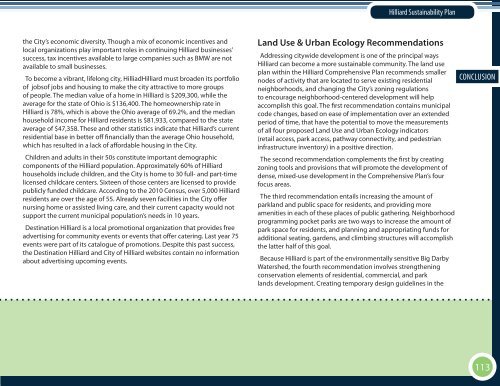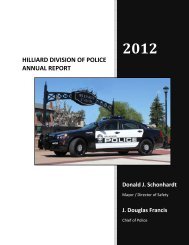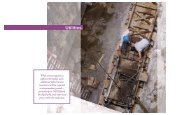The City of Hilliard Sustainability Plan
The City of Hilliard Sustainability Plan
The City of Hilliard Sustainability Plan
Create successful ePaper yourself
Turn your PDF publications into a flip-book with our unique Google optimized e-Paper software.
<strong>Hilliard</strong> <strong>Sustainability</strong> <strong>Plan</strong>the <strong>City</strong>’s economic diversity. Though a mix <strong>of</strong> economic incentives andlocal organizations play important roles in continuing <strong>Hilliard</strong> businesses’success, tax incentives available to large companies such as BMW are notavailable to small businesses.To become a vibrant, lifelong city, Hilliad<strong>Hilliard</strong> must broaden its portfolio<strong>of</strong> jobs<strong>of</strong> jobs and housing to make the city attractive to more groups<strong>of</strong> people. <strong>The</strong> median value <strong>of</strong> a home in <strong>Hilliard</strong> is $209,300, while theaverage for the state <strong>of</strong> Ohio is $136,400. <strong>The</strong> homeownership rate in<strong>Hilliard</strong> is 78%, which is above the Ohio average <strong>of</strong> 69.2%, and the medianhousehold income for <strong>Hilliard</strong> residents is $81,933, compared to the stateaverage <strong>of</strong> $47,358. <strong>The</strong>se and other statistics indicate that <strong>Hilliard</strong>’s currentresidential base in better <strong>of</strong>f financially than the average Ohio household,which has resulted in a lack <strong>of</strong> affordable housing in the <strong>City</strong>.Children and adults in their 50s constitute important demographiccomponents <strong>of</strong> the <strong>Hilliard</strong> population. Approximately 60% <strong>of</strong> <strong>Hilliard</strong>households include children, and the <strong>City</strong> is home to 30 full- and part-timelicensed childcare centers. Sixteen <strong>of</strong> those centers are licensed to providepublicly funded childcare. According to the 2010 Census, over 5,000 <strong>Hilliard</strong>residents are over the age <strong>of</strong> 55. Already seven facilities in the <strong>City</strong> <strong>of</strong>fernursing home or assisted living care, and their current capacity would notsupport the current municipal population’s needs in 10 years.Destination <strong>Hilliard</strong> is a local promotional organization that provides freeadvertising for community events or events that <strong>of</strong>fer catering. Last year 75events were part <strong>of</strong> its catalogue <strong>of</strong> promotions. Despite this past success,the Destination <strong>Hilliard</strong> and <strong>City</strong> <strong>of</strong> <strong>Hilliard</strong> websites contain no informationabout advertising upcoming events.Land Use & Urban Ecology RecommendationsAddressing citywide development is one <strong>of</strong> the principal ways<strong>Hilliard</strong> can become a more sustainable community. <strong>The</strong> land useplan within the <strong>Hilliard</strong> Comprehensive <strong>Plan</strong> recommends smallernodes <strong>of</strong> activity that are located to serve existing residentialneighborhoods, and changing the <strong>City</strong>’s zoning regulationsto encourage neighborhood-centered development will helpaccomplish this goal. <strong>The</strong> first recommendation contains municipalcode changes, based on ease <strong>of</strong> implementation over an extendedperiod <strong>of</strong> time, that have the potential to move the measurements<strong>of</strong> all four proposed Land Use and Urban Ecology indicators(retail access, park access, pathway connectivity, and pedestrianinfrastructure inventory) in a positive direction.<strong>The</strong> second recommendation complements the first by creatingzoning tools and provisions that will promote the development <strong>of</strong>dense, mixed-use development in the Comprehensive <strong>Plan</strong>’s fourfocus areas.<strong>The</strong> third recommendation entails increasing the amount <strong>of</strong>parkland and public space for residents, and providing moreamenities in each <strong>of</strong> these places <strong>of</strong> public gathering. Neighborhoodprogramming pocket parks are two ways to increase the amount <strong>of</strong>park space for residents, and planning and appropriating funds foradditional seating, gardens, and climbing structures will accomplishthe latter half <strong>of</strong> this goal.Because <strong>Hilliard</strong> is part <strong>of</strong> the environmentally sensitive Big DarbyWatershed, the fourth recommendation involves strengtheningconservation elements <strong>of</strong> residential, commercial, and parklands development. Creating temporary design guidelines in theCONCLUSIONECON. EXECUTIVE DEV.113






